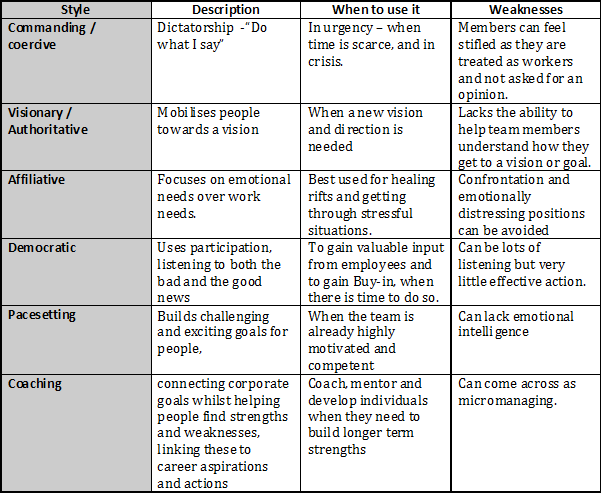Each of the Six Leadership styles comes from the use of Emotional Intelligence: Being acutely aware of the environment, his/her emotional needs and feelings and adjusting the style to suit the most appropriate setting.
These models can be seen below, which summarises the techniques, scenarios of when they work best and the impact on the organisation and its goals.

Coercive Leader
The coercive leader, which is one of the most aggressive of the six Leadership Styles, expects and demands immediate compliance to his/her orders. He/She has a style that accomplishes tasks by ordering and dictating, even demeaning his/her followers at times.
This style is best used in situations where the company or followers require a complete turnaround attempt which is quite urgent and there is no real time for active group discussions. An example could be during disasters or dealing with underperforming employees. Another example would be to enforce Health and safety compliance improvements under law.
This style should only be used for short time frames, just to get the job done, as the long term impact can be negative.
Authoritative Leader
The second of the Six Leadership Styles, the Authoritative Leader establishes him/herself as being the expert in the company. One who is a visionary and sees the way forward, leading the company to success.
Although the Authoritative leader leads the team to the vision, he/she will utilise the team to establish how they get there by themselves. This style is particularly effective in times when a new direction is needed: for someone to come up with the vision and the way forward.
Affiliative Leader
The Affiliate Leader is renowned for building teams; for putting employees first. Employees can expect a great deal of praise and feedback and there is normally a good sense of interconnection with the team.
This style is most effective when there are situations of low morale and poor teamwork. Utilising this method will, in the longer term, create good team bonding and heightened team performance.
The negative aspect can be that poor performance will go by without feedback as the Leader may feel that conflict will upset the balance. –In this instance, one must be mindful to adjust their style to suit positive feedback when necessary.
Democratic Leader
The Democratic Leader will use the team as decision makers – taking the team vote to make decisions and improvements. Communication is key in this model, whereby all opinions are listened to as a group. The Democratic Leader is merely the chair for effective team decision making.
When and only when the workplace is ready for Democratic Leaders, this style produces a work environment that employees can feel good about with heightened morale levels. Workers feel that their opinion counts, and because of that feeling they are more committed to achieving the goals and objectives of the organisation.
Remember, decisions still have to be made, so effect decisions in a timely manner must be the tip of the day when using this method!
Pacesetting Leader
Only when employees are self-motivated and highly skilled, the Pacesetting Leadership method comes into its own and is extremely effective. These Leaders set very high performance standards for themselves and the group and epitomize the behaviours they are seeking from other members of the group.
Like the Coercive model, this is another of the Six Leadership Styles that cannot be sustained for a long time as workers can often “burn out” due to its demanding pace expected from them. This is worth bearing in mind when using. A good example of when to use this method is when a group has been functioning together as an effective team for a while and are now performing in a good team culture. At this point, the Leader may wish to step things up and move to a new level of performance for a project or short term goal.
Coaching Leader
In the Coaching Leadership Style the leader focuses purely on helping others in their personal development, and in their job-related activities towards a goal. With the use of this style, the Leader helps team members upskill and become successful in their development, working closely with, coaching, developing, and mentoring them to ensure they have the knowledge and skills to be successful.
This style works best when the employee already understands their weaknesses, and is receptive to improvement suggestions or ideas. Be careful with over use, as this can come across as micromanaging the team. If used well, this is, however, an effective style to develop a learning organisation.
To Conclude
While coercion and pacesetting do indeed have their uses, research suggests that these styles can damage the organisation’s ‘working atmosphere’ in the longer term. This will ultimately reduce flexibility and employee commitment. – So the key is to use only when needed and in a small time frame.
In comparison, the other four of the Six Leadership styles have a proven positive impact on the Working environment and also performance.
Again, the most effective leader is one who can master at least four of the styles, and who can use the style to suit the situation. Remember, even the coercion and Pacesetting roles have their uses, you just have to use them only when the situation dictates.
